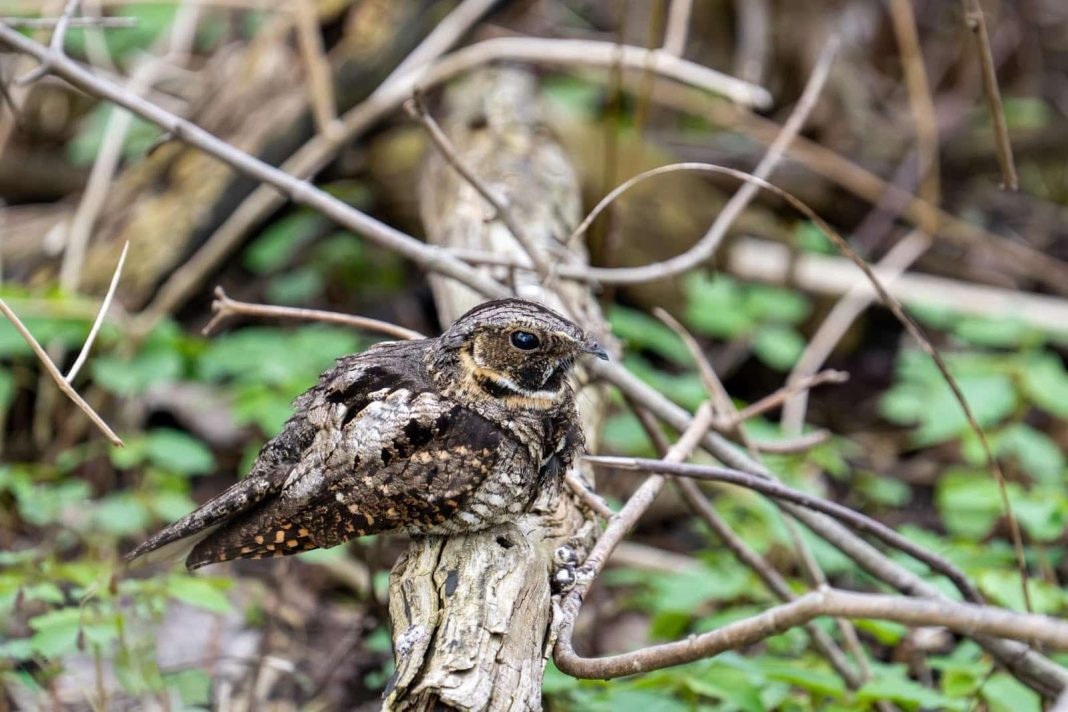By Kirsten Bartlow
Some sounds just say summer – the chorus of calling insects, water lapping against the shore, the sizzle of meat hitting the grill and the hum of a lawnmower.
What about the incessant, nighttime cadence of the eastern whip-poor-will? If you’re unfamiliar with this one, fair warning, the bird’s chanting inspires songs and poetry in some while vexing others. Click here for a sample, courtesy of Cornell Laboratory.
Although not technically a songbird, the male whip-poor-will may chant its call hundreds of times on a warm summer night, especially under a full moon. Whip-poor-wills haunt Arkansas nights April through September, while winters are spent in Mexico and Central America. The species may be heard in south central Arkansas and in the Delta during their migration, but breeding occurs in the northwestern third of the state. City dwellers may not be familiar with the bird’s iconic call; it seeks out forests and woodlands with open understories.
Good luck spotting one of these cryptically-colored birds. Gray and brown plumage camouflages them during daylight as they snooze on limbs close to the ground with their body parallel to the branch. For those lucky enough to sneak a peek, it’s fair to say their appearance is odd – big eyes, a tiny bill and a large gaping mouth all the better for gulping down insects.
Add to their oddities the names that surround them, “goatsucker” being at the top of the list. This head-scratcher of a name goes way back to Aristotle, the ancient Greek philosopher. He veered out of his wheelhouse when he wrote that members of the nightjar family (we’ll get to that nickname), which includes whip-poor-wills, swoop in during the cover of darkness and suck milk from goats’ udders. The reality? The birds were likely flying about and dining upon insects associated with the goats.
This widespread myth had a lasting effect – whip-poor-wills and their kin belong to the Caprimulgidae family, derived from Latin and meaning “milker of goats,” and are still referred to as goatsuckers. This same family of birds – including the common nighthawk and chuck-will’s-widows in Arkansas – are also referred to as nightjars. This one is easier to understand with their nocturnal habits and incessant calling that is jarring to some.
Whip-poor-wills hunt at dawn, dusk, and during a full moon and will also take advantage of insects attracted to stadium and street lights. A cavernous mouth outlined by stiff feathers efficiently gobbles up an assortment of insects: moths, beetles, grasshoppers, stoneflies, ants, bees, wasps, fireflies and weevils.
A nighttime drive in a rural area may unveil the bird sitting in the road while the sweep of headlights reveals glowing red orbs from the reflective membrane in the bird’s eyes that assists with night vision.
Whip-poor-wills are in tune with the lunar cycle and lay their eggs so that young hatch about 10 days before a full moon. When the moon is near full, the adults forage all night, catching large numbers of insects to feed their hungry nestlings.
Nest building is not a part of their repertoire, and the female lays eggs directly on leaf litter, tucked in on the north side of a shrub that offers shade from the hot afternoon sun. At about eight days old, the chicks, covered in orange-tan down, molt into highly camouflaged plumage. The male takes over care of the young, calling and patrolling along his territory and chasing off intruders with aggressive calls, hisses, raised wings and an open mouth. Both parents will feign injury to lead predators away from the nest.
Chuck-will’s-widows, the equally vocal relative of the eastern whip-poor-will, is larger with a bigger head and prefers more open habitat. Some listeners may mistakenly identify the call as a whip-poor-will, but each song has a distinct pitch and cadence that’s unmistakable once heard. Listen to this sample and hear for yourself.
The chuck-will’s-widow’s feeding habits are similar to whip-poor-will’s. It may also gobble up an occasional small bird or bat with its gaping mouth.
Data collected by the North American Breeding Bird Survey shows a significant decline in both nightjars between 1966 and 2019. Like other species of wildlife, habitat loss is their main nemesis. Other woes include collisions with cars along with buildings during nocturnal migration, nest predation and insecticides.
Whip-poor-wills are a feathered form of Americana. Songs referencing their iconic chanting in eastern forests abound in country music with its nostalgia for rural life.
Get involved with concerned conservationists and citizens who want to hear the birds’ onomatopoeic calls for years to come. The Nightjar Survey Network relies on volunteers to run survey routes: www.nightjars.org
The AGFC and other conservation organizations actively manage habitat across the state with prescribed fire and other tools to open the forest understory, which benefits a suite of wildlife species, including whip-poor-wills and chuck-will’s-widows. Landowners looking to improve their habitat for wildlife will find assistance through AGFC’s Conservation Incentive Program: www.agfc.com/education/






